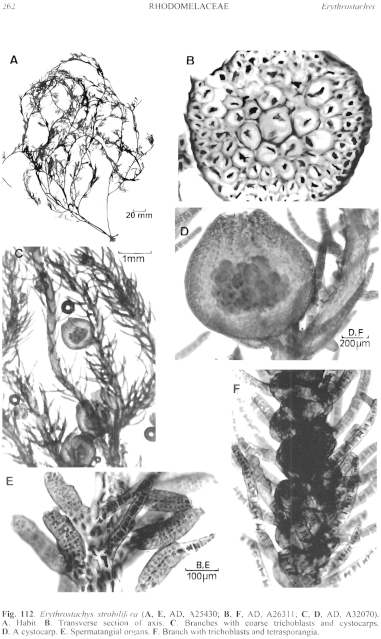|
|
|
|
|
|||||||||||
|
Electronic Flora of South Australia Species Fact Sheet
Phylum Rhodophyta – Family Rhodomelaceae – Tribe Lophothalieae
Synonyms
Lophothalia strobilifera J. Agardh 1890: 60.
Brongniartella strobilifera (J. Agardh) Schmitz 1893: 218. De Toni 1903: 1012. Lucas 1909: 43. Lucas & Perrin 1947: 283.
Erythrostachys prolifera White in Ewart et al. 1912: 257, pl. 52 figs 3–7.
Rhodolophia strobilifera (J. Agardh) Kylin 1956: 510. May 1965: 379. Shepherd & Womersley 1981: 367.
Thallus (Fig. 112A) dark red-brown, 10–40 cm high, with robust, branched, corticated, cartilaginous axes 0.5–2 mm in diameter, bearing lateral, branched tufts 1–3 (–7) cm long with lightly corticated branches, covered with rhodoplastic trichoblasts, probably proliferous. Holdfast discoid, soon becoming divided, 5–15 mm across, branches 400–800 µm thick; epilithic. Structure monopodial, apical cells hemispherical, subapical cells 10–20 µm in diameter, bearing trichoblasts from axial cells 3–8. Pericentral cells 7 (Fig. 112B), cut off from segments just below the apical cell. Trichoblasts (Fig. 112C, F) rigid, 700–1250 µm long. basally once (occasionally twice) furcate with adherent basal walls at the dichotomy, branches straight or slightly curved, 60–100 µm in diameter with cells L/D 0.8–1.2 below, tapering slightly until near their tips, subterminal cells 25–30 µm in diameter, terminal cell acute; adventitious filaments absent. Cortication commencing 8–10 segments from apices, remaining slight except on main branches and axes; pericentral cells remaining clear (Fig. 112B) in transverse section, with small outer cortical cells. Cells probably uninucleate; rhodoplasts discoid.
Reproduction: Gametophytes dioecious. Procarps borne on a basal cell of a trichoblast or the cell just above a furcation. Carposporophyte with a basal fusion cell producing relatively slender gonimoblast filaments with shortly clavate to ovoid terminal carposporangia 90–140 µm in diameter. Cystocarps (Fig. 112C, D) ovoid, 0.7–1.2 mm in diameter, sessile, with no neck; pericarp ostiolate, 4 cells thick, lightly corticated. Spermatangial organs (Fig. 112E) on branches of trichoblasts, with sterile basal and apical cells, 100–300 µm long and 60–80 µm in diameter, with initials cutting off an outer layer of spermatangia.
Tetrasporangia occur on corticated branches bearing normal trichoblasts (Fig. 112F), fertile parts 2–5 mm long and 400–600 µm in diameter(including the torulose tetrasporangia), strongly torulose with the large sporangia, one per segment and spirally arranged, 180–230 µm in diameter, lightly corticated.
Type from "Adelaide", S. Aust.; lectotype (tetrasporangial) in Herb. Agardh, LD, 42047, isolectotype (cystocarpic) LD, 42943.
Selected specimens: Eyre, W. Aust, drift (Parsons, 22.xi.1968; AD, A35128). Elliston, S. Aust., drift (Womersley, 13.i.1951; AD, A13528). Wanna, S. Aust., drift (Womersley, 19.ii.1959; AD, A22411). Victor Harbour, S. Aust., drift (Womersley, 16.ii.1963; AD, A26311). Port Elliot, S. Aust., drift (Womersley, 26.xi.1961; AD, A25430 and (Parsons, 15.i.1968; AD, A32070). Vivonne Bay, Kangaroo I., S. Aust., drift (Womersley, 2.i.1949; AD, A10621). Seal Bay, Kangaroo I., S. Aust., drift (Womersley, 21.i.1965; AD, A28701).
Distribution: Eyre, W. Aust., to Port Elliot, S. Australia.
Taxonomic notes: The holotype of Erythrostachys prolifera White is in MEL, 608416, from Encounter Bay, Hussey, (an Algae Muellerianae specimen, det. by J. Agardh), accompanied with notes of Reinbold and drawings published by White.
E. strobilifera is apparently a deep-water species on rough water coasts, known only from occasional drift specimens. Further study is needed to clarify reproductive details.
References:
AGARDH, J.G. (1890). Till algernes systematik. Acta Univ. lund. 26(3), 1–125, Plates 1–3.
DE TONI, G.B. (1903). Sylloge Algarum omnium hucusque Cognitarum. Vol. 4. Florideae. Sect. 3. pp. 775–1521 + 1523–1525. (Padua.)
EWART, A.J., WHITE, J., REES, B. & WOOD, B. (1912). Contribution to the Flora of Australia, No. 18. Proc. R. Soc. Vict. 24(N.S.), 255–269, pls 52–56.
KYLIN, H. (1956). Die Gattungen der Rhodophyceen. (Gleerups: Lund.)
LUCAS, A.H.S. & PERRIN, F. (1947). The Seaweeds of South Australia. Part 2. The Red Seaweeds. (Govt Printer: Adelaide.)
LUCAS, A.H.S. (1909). Revised list of the Fucoideae and Florideae of Australia. Proc. Linn. Soc. N.S.W. 34, 9–60.
MAY, V. (1965). A census and key to the species of Rhodophyceae (red algae) recorded from Australia. Contr. N.S. W. Natl Herb. 3, 349–429.
SCHMITZ, F. (1893). Die gattung Lophothalia, J. Ag. Ber. Deutsch. Bot. Ges. 11, 212–232.
SHEPHERD, S.A. & WOMERSLEY, H.B.S. (1981). The algal and seagrass ecology of Waterloo Bay, South Australia. Aquat. Bot. 11, 305–371.
The Marine Benthic Flora of Southern Australia Part IIID complete list of references.
Publication:
Womersley, H.B.S. (24 February, 2003)
The Marine Benthic Flora of Southern Australia
Rhodophyta. Part IIID. Ceramiales – Delesseriaceae, Sarcomeniaceae, Rhodomelaceae
Reproduced with permission from The Marine Benthic Flora of Southern Australia Part IIID 2003, by H.B.S. Womersley. Australian Biological Resources Study, Canberra. Copyright Commonwealth of Australia.
Illustration in Womersley Part IIIA, 2003: FIG. 112.

Figure 112 enlarge
Fig. 112. Erythrostachys strobilifira (A, E, AD, A25430; B, F, AD, A26311; C, D, AD, A32070). A. Habit. B. Transverse section of axis. C. Branches with coarse trichoblasts and cystocarps. D. A cystocarp. E. Spermatangial organs. F. Branch with trichoblasts and tetrasporangia.

|
Email Contact: State Herbarium of South Australia |

|